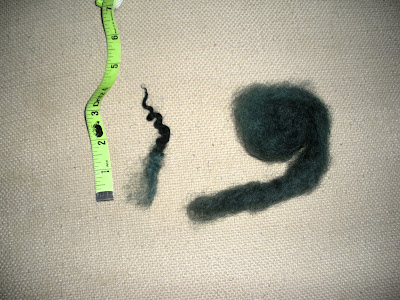When we were kids, most of us did crafts with felt - in premade sheets. All you had to do was cut it in the shape you wanted, and it could be used as a stiff fabric or like textured paper. I think I still have a little pillow somewhere make out of those sheets and stapled together.
There is also needle felting. I don't do that craft, and I know very little about it, except that they sell the cutest little kits at Maryland Sheep and Wool festival.
When you are processing fleece, especially fine fleece, felting is the thing you live in dread of. Just a little too much agitation, or the wrong temperature of water, and a beautiful bit of wool becomes unspinnable.
Then there is the felting that knitters do, although it is technically "fulling".
Fulling a knitted fabric shrinks it and removes stitch definition. It smoothes out the fabric, and stiffens it. It often makes it warmer as well, thickening it and shrinking the holes. You can full the fabric a bit, just to make it more form-fitting, or a lot, to make it closer to a true felt.
In general, felting or fulling only works with animal fibers, particularly wool. Agitating and/or temperature changes cause microscopic "hooks" in the fibers to catch on each other.
All of this is to say that I experimented with a bit of fulling recently, and I may be doing some more soon.
I made some felted dryer balls to use up some waste wool and ugly yarn. They supposedly make the dryer more efficient and possibly soften the laundry without chemicals.
I used two different handspun yarns that were fairly ugly, a green single-ply and a yellow two-ply:
 |
| yellow 2-ply |
 |
| The green yarn was so bad I didn't ever take a picture of it. Here some of the fiber it was made from. |
The green was made from coopworth wool combing waste, while the yellow was made from commercial top from an unspecified breed of sheep.
I made identical balls from the two yarns, and fulled them in the dryer (so much easier than the old fashioned way):
 |
| From left to right: an unstuffed "case"; a pre-felted ball; and a post-felted ball |
Some possible explanations:
- I stuffed the green ones with more fiber
- The fiber that I stuffed the green ones with had the lock structure broken apart, which made it felt better
- The single-ply felted easier than the two-ply
- Unbeknownst to me, the yellow wool is a super-wash wool (the "hooks have been chemically removed so that the wool won't felt)
- The yellow yarn is thicker, so it couldn't shrink as much
- Any or all of the above





Neat! I've been thinking about experimenting with felting, too, though I had not realized I should be saying "fulling".
ReplyDelete-Erica